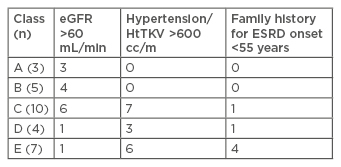Autosomal dominant polycystic kidney disease (ADPKD) patients show end-stage renal disease (ESRD) progression, which requires suitable biomarkers to identify. While estimated glomerular filtration rate (eGFR) remains in normal ranges for several years before renal impairment, there is a direct negative correlation between kidney volume (normalised according to the patient’s height adjusted [HtTKV]) and eGFR. This has recently highlighted a HtTKV-based classification to stratify patients according to their risk of developing kidney failure. Five patient classes have been identified (1A–1E), in which eGFR decline ranges from 0.23–4.78 mL/min/1.73 m2/year (males) and 0.03–4.58 mL/min/1.73 m2/year (females).
We have conducted a prospective study enrolling 29 APKD patients (12 males and 17 females). Renal function and HtTKV were evaluated by CKD-EPI formula and kidney nuclear magnetic resonance, respectively. HtTKV values were between 224 and 3,091 cc/m, and patients were therefore divided into five groups according to the classification previously described (see Table 1). In the patients’ cohort, eGFR was found to range from 12–107 mL/min/1.73 m2 (15 patients showed a CKD-EPI eGFR >60 mL/min/1.73 m2, while 14 patients had an EPI eGFR <60 mL/min). Among Class D patients, three-quarters of patients had eGFR <60 mL/min/1.73 m2, as did 6 out of 7 Class E patients. Among Class B patients, only 1 patient showed an CDK-EPI eGFR <60 mL/min/1.73 m2, as did 4 out of 10 Class C patients. Early-onset hypertension was exhibited in 20 out of 29 patients <35 years old. In this hypertensive group, an HtTKV >600 cc/m was observed in 16 patients. An ESRD-familiar history was observed in 9 patients <55 years old (3 Class C, 1 Class D, and 5 Class E patients). For each patient a prognostic evaluation was performed according to a ‘slope’ model derived by Mayo Clinic classification; 10-year progression towards Stage 3 CKD was estimated in 6 out of 15 patients with eGFR >60 mL/min/m2. At the same time, 6 out of 14 patients with eGFR <60 mL/min/m2 were estimated to develop ESRD in a 5-year period, with 6 more predicted to develop the disease over a 10-year period. The last 2 patients were estimated to develop Stage 4 CKD over a 10-year period.

Table 1: Classification of autosomal dominant polycystic kidney disease patients.
eGFR: estimated glomerular filtration rate; HtTKV: height adjusted total kidney volume; ESRD: end-stage renal disease.
Although conducted on a small sample size, our data suggest the clinical utility of kidney volume assessment in ADPKD patients, especially for prognostic evaluation, allowing the identification of patients at higher risk of developing ESRD.






